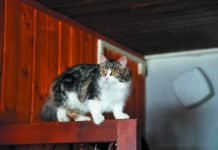Aggression is second only to litter box issues when it comes to reasons people with cats make an appointment to see a veterinary behaviorist. They are smart to seek professional help. While feline aggression is sometimes taken less seriously than canine aggression, it shouldn’t be, says the ASPCA. Dogs only bite, but a cat can bite or scratch. Either tactic can cause painful skin tears. Moreover, cat bite wounds have the capacity for deep penetration and frequently lead to infection. Sometimes the scratches cause cat scratch fever, a potentially serious infection capable of bringing on flu-like symptoms.
Feline aggression doesn’t always manifest itself as an outright attack. Sometimes it amounts to hissing or other threatening behavior and avoiding the target of the aggression — a person or another cat. Either way, it’s not good for the people or other cats in your home; frequent aggression can make life unpleasant, as if you’re walking on eggshells. It’s not good for the cat, either. It means he’s in emotional distress.
There are a number of categories of feline aggression, some easier to identify and resolve than others. Whatever the type of aggression, the ASPCA advises not touching a cat, not attempting to reassure him, and not punishing him when he is in the middle of taking an aggressive posture or in the throes of aggression. Intervening at those moments won’t calm him and may end up hurting you.
Types of aggression with relatively easy solutions
Aggression induced by petting. You love stroking your cat, and he in turn loves being stroked — until he doesn’t. You might want the bonding to go on longer, but put yourself in your cat’s shoes. Imagine, for instance, that you are being given a massage. What starts out feeling good can become irritating, especially if the person keeps kneading the same spot on your back over and over. You can tell the massage therapist it’s not feeling good anymore. Your cat doesn’t have that recourse, so might communicate his displeasure with a scratch or bite.
It’s worth keeping in mind that “many cats do not enjoy being touched below the neck, says Tufts animal behaviorist Stephanie Borns-Weil, DVM. “Cats mostly touch each other on the head,” she notes. (The exception to the not-below-the-head rule between cats is grooming, which occurs only between cats who have already bonded.)
In addition, Dr. Borns-Weil, says, “cats are more sensitive to touch than people—literally.” They have a greater density of touch receptors in each square inch of skin compared to people. Thus, “prolonged touch may actually not feel good to them,” the doctor says. Finally, she comments, “our interaction styles are different. People are high-intensity low-frequency interactors. We want a few long, intense interactions with our cats. Cats are high-frequency low-intensity interactors by nature. They want lots of little interactions.”
Watch for the warning signs that a cat has had enough: he quickly turns his head toward your hands or twitches or flips his tail. He may also flatten his ears or rotate them forward or back. In addition, he may grow restless, and his pupils might dilate. In those instances, back off. Better yet, back off before you notice any signs that he is itching to react aggressively. Let your cat call the shots. He’ll tell you if he wants more stroking after you stop.
Aggression induced by pain. Like some people, some cats may become aggressive when they are in pain. Known in some circles as irritable aggression, pain-induced aggression can occur when a cat is hurt or when someone tries to touch that part of him that is feeling pain. One example might be if you go to put ear drops in his ears when he has an ear infection. Pain can also cause him to react in anticipation of being handled, or during the handling itself.
For this reason, cats who are acting aggressively, especially if their aggression is new or newly emphatic, should be examined by a veterinarian to see if there’s an underlying medical issue that requires tending. Particularly painful conditions that might cause a cat to initiate physical conflict include dental disease and arthritis. You might not be able to see these conditions as you would a bloody wound, but they could be wearing a cat’s nerves thin nonetheless.
Maternal aggression. Most people with cats will never experience this firsthand, but like all new mothers, a cat mother (called a “queen”) may act aggressively when she perceives her offspring are being threatened by the approach of people or other animals. Queens can act particularly aggressive in the first few days after they give birth, most notably toward other cats. But even for people, it’s not a bad idea to avoid handling kittens the first few days of their lives, especially if their mother is showing signs that she’s not happy about it. An angry scratch or bite can happen well in advance of your having the opportunity to move away.
Next month: Feline aggression triggers that are harder to identify — and treat.
The ASPCA lists the following signs as advance warnings that a cat
may strike:
➤ Stiff, straight-legged upright stance.
➤ Stiffened rear legs, with the rear end raised and the back sloped downward toward the head.
➤ Tail stiff and lowered or held straight down to the ground.
➤ Direct stare.
➤ Upright ears, with the backs rotated slightly forward.
➤ Piloerection (hackles up), including fur on the tail.
➤ Constricted pupils.




